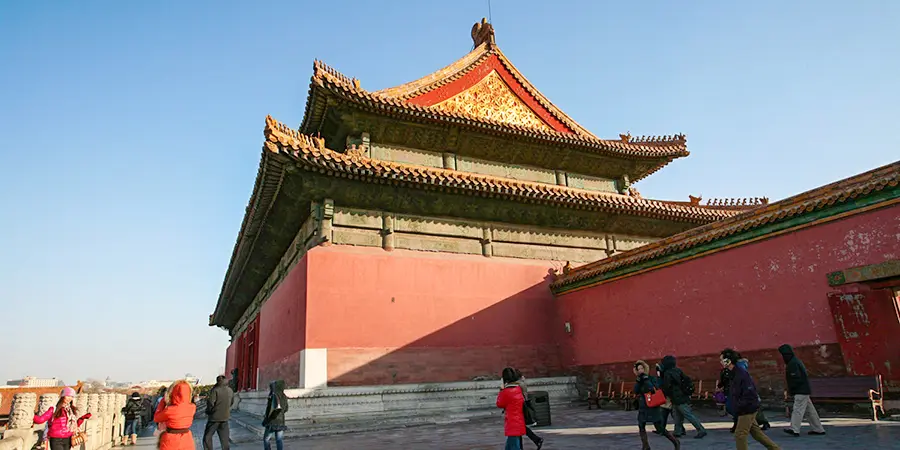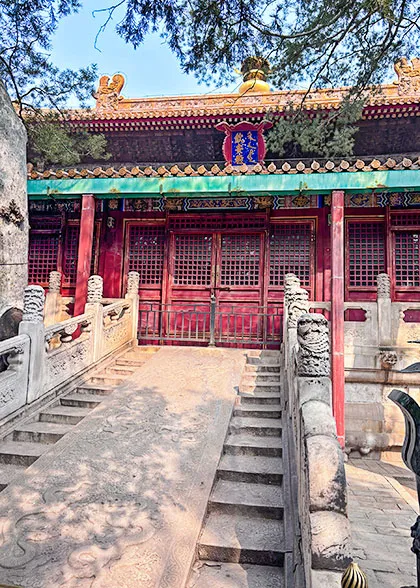Hall of Imperial Peace (Qin’andian) was built in 1420 in the
Ming Dynasty (1368-1644) in the
Imperial Garden in the right north of the
Forbidden City, and it became an independent yard after the surrounding walls were added in 1535. It was a place to worship Taosim Lord Zhenwu in the Ming and
Qing Dynasties (1403-1911). They believed he could protect the imperial palace from fires. In 2004, when Qin’andian was under renovation, people accidentally found many hidden scriptures, which makes this place all the more mysterious. Now, Qin’andian is open to tourists.
Worship Hall of a Taosim Lord Controlling the North and Preventing Fires
The Hall of Imperial Peace was built for worshiping Lord Zhenwu. Lord Zhenwu is a mythical figure in Chinese
Taoism, and he is believed to control the north. When Yongle Emperor (1360-1424), the third emperor in the Ming Dynasty, ascended the throne, he often compared himself to Lord Zhenwu, in order to show the supremacy of his governance. Therefore, Qin’andian was built in the very north of Forbidden City during this period.
Later, during the Jiajing Period (1522-1566) in Ming Dynasty, the Forbidden City caught fire from timeto time. According to the superstition at that time, fire meant the lack of water, and water could only be found in the north. In this way, Lord Zhenwu was added with another religious function of fire prevention. Therefore, Jiajing Emperor practiced Taoism even more piously and asked people to renovate Qin’andian and the statue of Lord Zhenwu.
Though emperors in Qing Dynasty (1636-1912) didn’t believe in Taoism, they still showed respect to this religious hall. Kangxi Emperor (1661-1722) and Yongzheng Emperor (1722-1735) both held ceremonies in Qin’andian to pray for the happiness and longevity for the empress dowagers. Besides, on January 1st, and from August 6th to 18th in Chinese lunar calendar, emperors would burn incense here and conduct other Taoist rites, so as to guard against fires in the Forbidden City.
 |
Tianyi Gate
Built in 1535 in the Ming Dynasty, Tianyi Gate is the front gate of Qin’andian. “Tianyi” in ancient Chinese means producing water, which was another attempt to prevent fire. The red doors of this arch gate is inlaid with gilded copper doornails, which are arranged along nine rows and nine columns. The roof of Tianyi Gate is covered with yellow glazed tiles, while the corbel arches are made from green ones. On both sides of the gate stand two screen walls, whose corners and central parts are decorated with exquisite cranes and clouds. Two sculptures of Chinese mythical animals and one bronze censer are also placed outside the gate. What’s more, Tianyi Gate is mainly made from green bricks, and this elegant color well suits the serenity of the Imperial Garden.
Hall of Imperial Peace
 |
| Hall of Imperial Palace |
Entering through Tianyi Gate, you will enter the independent yard for the Hall of Imperial Peace. The hall was built on the foundation made of white marble, and its roof was paved with yellow glazed tiles. In the east and the west of the yard, two square pavilions with pyramidal roof were built during Qianlong Period (1736-1795). And in the southeast corner of the yard, there is a stove used for burning ritual items. Moreover, there are two lacebark pines in front of the hall, and the contrast between green needles and white marbles is very visually appealing.
Compared with other buildings in the Forbidden City, Qin’andian boasts the beautiful stone carvings. For example, in the front platform, the banisters made of white marble is engaved with delicate flowers and dragons; the top of the banister also has the statuettes of dragon and phoenix; and a stone plate at the rear is vividly carved with two dragons swimming in the sea. Other patterns like sea, wave and marine animals can also be found in Qin’andian, which conveys people’s wish for water at that time.
Statue of Lord Zhenwu
The statue is worshipped inside the Hall of Imperial Peace. It has the height of 2m (6.6ft) and is well proportioned. The august Lord Zhenwu is made of gilded bronze and carved into a sitting gesture. He has a high forehead, thin eyes, tilting moustache and long beard, with his naked left foot stepping on the clound and right hand holding a sword. Lord Zhenwu also wears a belt inlaid with twenty jades, with a ribbon floating across his shoulder. The carving is so lifelike that the Lord Zhenwu’s firm muscles even seem real under the golden armor. Moreover, the edge of armors on his shoulder and leg is carved into the pattern of falcon’s feather, which stands for ultimate prowess. In front of the statue is a bronze turtle and Lord Zhenwu’s sacred plate.
Unexpected Discovery of Buddhist Scriptures
In September, 2004, the Forbidden City was conducting a new round of renovation, and the Hall of Imperial Peace was also included. When the workers were checking its general condition, someone found the sawdust inside the grooves on the roof. At first, workers thought that the roof must be damaged by worms, and then decided to drill a hole and take a further look. However, the drill moves into the roof incredibly smoothly, and everyone was shocked that the roof of Qin’andian was hollowed to store something! Workers instantly fetched the staff members who were in charge of cultural relics. After a while, over 3,000 scriptures were taken out of the roof. According to the legible printing, these scriptures belonged to Tibetan Buddhism, and were hidden in the roof during Qianlong Period in the Qing Dynasty (1736-1795). However, why Qianlong put scriptures inside the hollow roof is still a mystery. After the renovation, only a few scriptures were taken out and collected by the Forbidden City and the most were put back in the roof.
 Next:
Next:
 Go west or east to see the Imperial Garden (Yuhuayuan);
Go west or east to see the Imperial Garden (Yuhuayuan);
 Go South to see the Palace of Earthly Tranquility (Kunninggong).
Go South to see the Palace of Earthly Tranquility (Kunninggong).
 Note: On the west side is the Studio of Cleansing Fragrance (Shufangzhai), which is not open to tourists yet.
Note: On the west side is the Studio of Cleansing Fragrance (Shufangzhai), which is not open to tourists yet.
 Further Reading:
Further Reading:
How to visit the Forbidden City
- Last updated on Aug. 01, 2025 by Gabby Li -


![]() Next:
Next:![]() Go west or east to see the Imperial Garden (Yuhuayuan);
Go west or east to see the Imperial Garden (Yuhuayuan);![]() Go South to see the Palace of Earthly Tranquility (Kunninggong).
Go South to see the Palace of Earthly Tranquility (Kunninggong).![]() Note: On the west side is the Studio of Cleansing Fragrance (Shufangzhai), which is not open to tourists yet.
Note: On the west side is the Studio of Cleansing Fragrance (Shufangzhai), which is not open to tourists yet.![]() Further Reading:
Further Reading: